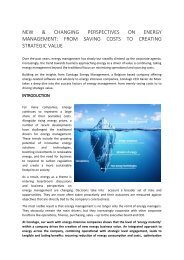Accurate Allocation of energy in production processes - the importance of using metamodels
Many companies struggle with correctly monitoring, allocating and distributing direct and indirect energy consumption over all internal and external customers, users or products. In this age of rising commodity costs and additional attention to sustainability, the advantages of adequately allocating energy are nonetheless substantial: 1. Real-time mapping of energy throughout process flows makes it easier to detect deviations in energy conversions during production processes, find the root causes and reduce losses. 2. Using exact and objective keys for allocating energy consumption speeds up periodic P&L and CSR reporting and makes for more accurate reports. 3. Continuous, real-time distribution of energy cost among users increases transparency and raises awareness with them. Although most companies already struggle with integrating correct data from metered equipment, this is only the first - albeit important - step. The crux is fully understanding the nature and efficiency of energy conversions processes; energy inflows and outflows to different customers; fixed and variable costs and corporate structures. By using metamodels - designed for and maintained by energy managers - all this information is added to the initial metered data and processed in such a way that any change from an energy point of view instantly leads to adjustments in the energy allocation. This white paper reviews emerging trends and challenges in energy allocation and examines the working and benefits of using specific metamodels at the level of energy management software.
Many companies struggle with correctly monitoring, allocating and distributing
direct and indirect energy consumption over all internal and external customers,
users or products. In this age of rising commodity costs and additional
attention to sustainability, the advantages of adequately allocating energy are
nonetheless substantial:
1. Real-time mapping of energy throughout process flows makes it easier
to detect deviations in energy conversions during production processes,
find the root causes and reduce losses.
2. Using exact and objective keys for allocating energy consumption
speeds up periodic P&L and CSR reporting and makes for more accurate
reports.
3. Continuous, real-time distribution of energy cost among users increases
transparency and raises awareness with them.
Although most companies already struggle with integrating correct data from
metered equipment, this is only the first - albeit important - step. The crux is
fully understanding the nature and efficiency of energy conversions processes;
energy inflows and outflows to different customers; fixed and variable costs
and corporate structures. By using metamodels - designed for and maintained
by energy managers - all this information is added to the initial metered data
and processed in such a way that any change from an energy point of view
instantly leads to adjustments in the energy allocation.
This white paper reviews emerging trends and challenges in energy allocation
and examines the working and benefits of using specific metamodels at the
level of energy management software.
You also want an ePaper? Increase the reach of your titles
YUMPU automatically turns print PDFs into web optimized ePapers that Google loves.
logically l<strong>in</strong>k <strong>the</strong> old and <strong>the</strong> new model to each o<strong>the</strong>r.<br />
The lack <strong>of</strong> pathways is a major impediment for <strong>energy</strong> report<strong>in</strong>g <strong>in</strong> complex<br />
and chang<strong>in</strong>g organisations.<br />
• Trend data are no longer mean<strong>in</strong>gful after a change. The <strong>in</strong>formation<br />
be<strong>in</strong>g reported - and <strong>the</strong> conclusions based on it - may or not be about<br />
<strong>the</strong> same entities or <strong>processes</strong> as before. The model itself will only<br />
allow for <strong>in</strong>terpretation based on <strong>the</strong> configuration based on <strong>the</strong> new<br />
situation, even when <strong>the</strong> bulk <strong>of</strong> <strong>the</strong> trendl<strong>in</strong>e is based on data be<strong>in</strong>g<br />
collected <strong>in</strong> <strong>the</strong> old situation. The issue is fur<strong>the</strong>r compounded when<br />
several, consecutive changes occur - each time wip<strong>in</strong>g out <strong>the</strong> mean<strong>in</strong>g<br />
that could have been given to older data read<strong>in</strong>gs.<br />
• The allocation <strong>of</strong> consumption or costs to entities, loses its value as<br />
a management tool. Whe<strong>the</strong>r <strong>the</strong> goal is to track performance, draft<br />
department P&Ls, do accurate cost account<strong>in</strong>g or <strong>in</strong>form CSR policy,<br />
<strong>the</strong> <strong>in</strong>formation ga<strong>in</strong>ed from a changed metamodel can no longer be<br />
put to use <strong>the</strong> same way as it may no longer cover <strong>the</strong> same underly<strong>in</strong>g<br />
elements.<br />
Versioned models <strong>of</strong>fer a solution. They are essentially a series <strong>of</strong> timestamped<br />
<strong>metamodels</strong>, each <strong>of</strong> which has been valid for a given period <strong>of</strong> time.<br />
Whenever a change occurs, <strong>the</strong> old version gets archived with <strong>the</strong> appropriate<br />
time stamp and <strong>the</strong> new one is generated. In addition, <strong>the</strong> l<strong>in</strong>ks between <strong>the</strong><br />
previous and <strong>the</strong> new model are made explicit. This means each new, changed<br />
or altered datapo<strong>in</strong>t must be highlighted as such; get its place <strong>in</strong> <strong>the</strong> overall<br />
structure and have its relationships with o<strong>the</strong>r datapo<strong>in</strong>ts def<strong>in</strong>ed. Examples<br />
<strong>in</strong>clude fitt<strong>in</strong>g an extra meter <strong>in</strong> a given process or add<strong>in</strong>g a new build<strong>in</strong>g to an<br />
exist<strong>in</strong>g department.<br />
Do note that a versioned model is a generalisation <strong>of</strong> a static one much <strong>the</strong><br />
same way a graph-based model is a generalisation <strong>of</strong> a hierarchical one. As<br />
long as <strong>the</strong>re are no changes to <strong>the</strong> underly<strong>in</strong>g <strong>energy</strong> or company structure,<br />
<strong>the</strong> version<strong>in</strong>g does not come <strong>in</strong>to play and <strong>the</strong> model is identical to a static<br />
one.<br />
15




